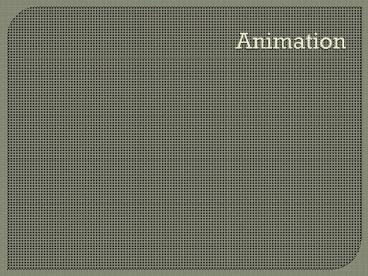Animation - PowerPoint PPT Presentation
1 / 20
Title:
Animation
Description:
The creation of moving pictures one frame at a time Literally 'to bring to life' e.g. make a sequence of drawings on paper, in which a character's position changes ... – PowerPoint PPT presentation
Number of Views:115
Avg rating:3.0/5.0
Title: Animation
1
Animation
2
Animation
242
- The creation of moving pictures one frame at a
time - Literally 'to bring to life'
- e.g. make a sequence of drawings on paper, in
which a character's position changes slightly in
each drawing - Photograph drawings in sequence, using movie
camera that advances one frame at a time - Play back resulting film character will move
3
Traditional Methods
243244
- Drawings/paintings on paper
- 1440 drawings for every minute of film
- Cel
- Painted or scratched film
- Cut-outs
- Clay animation (Claymation)
- etc
4
Captured Animation
245246
- Computer video camera traditional technique
- Frame grabbing record each frame to disk
- Save as QuickTime c, edit non-linearly like
video - Can also use scanner or digital still camera, or
create each frame in a graphics program (e.g.
Painter)
5
Digital Cel
249250
- Use layers (e.g. in Photoshop) like sheets of
acetate in traditional cel animation - e.g. static background on one layer, moving
simple object on a layer in front of it. Make the
object move by repositioning the layer - More complex cases, just need to change those
layers where movement or other change occurs
between frames
6
Sprite Animation
250
- Store a single copy of all static elements and
moving objects (sprites) and a description of how
the objects move - Each sprite can be a collection of images called
sprite faces, which can be substituted in
sequence to produce composite motion - e.g. walk cycle
7
Key Frame Animation
251252
- Traditional key frames drawn by chief animators
at important points in the animation - In-between frames drawn by less skilled animators
- Computer-based key frames drawn explicitly
- In-between frames interpolated by software
8
Linear Interpolation
252
- Constant velocity
- Motion begins and ends instantaneously
9
Easing In
253
- Object accelerates, gradual transition from
stasis to motion
10
Easing Out
253
- Object decelerates, gradual transition from
motion to stasis
11
Animated GIFs
247249
- Sequence of images can be stored in a single GIF
file, and displayed one after another by a Web
browser or other software - No browser plug-in required
- Can specify looping, delay between frames
- 256 colour palette
- No sound
12
SWF
254
- Popular Web animation format
- Usually generated by Macromedia Flash
- Vector animation format
- Motion represented as numerical operations on
vector data - Can also include bitmapped images (e.g. as
backgrounds)
13
Flash
254256
- Timeline graphical representation of sequence
of frames - Key frames drawn/copied from previous and
transformed - Simple frames hold on previous key frame
- Stage sub-window in which frames are created by
drawing with vector tools - Can also import bitmaps as objects, add text
14
Symbols
256257
- Reusable objects stored in a library
- Graphic symbols
- Button symbols (for interactivity)
- Movie clip symbols (self-contained animations
within a movie) - Create instances by dragging on to stage
- If symbol is edited, all its instances updated
15
Motion Tweening
256
- Motion tweening
- Object is placed in a key frame
- Create Motion Tween
- Object is turned into a symbol
- Add key frame at end of tweened sequence and move
or transform object - Motion in intermediate frames is interpolated
(tweened)
16
Shape Tweening
257
- Also called morphing
- Shapes of graphical objects are transformed in
between key frames - Have to generate the interpolated frames, so
resulting SWF is bigger than when motion tweening
is used
17
Motion Graphics
261266
- Like time-based graphic design
- Move, transform, alter layers of a bitmapped
image between frames - Apply time-varying filters and effects
- AfterEffects supports linear and Bézier
interpolation in both space and time (rate of
change) - Can have new effects that only make sense in
time, e.g. shatter, particle effects
18
3-D Animation
266267
- "Easy to describe but much harder to do"
- Properties of 3-D models (shape, size, position,
rotation, surface characteristics, etc), light
sources and cameras are numerically defined - Animate a scene by changing the numbers,
rendering a new frame, changing further - Can make objects move, or move the camera
- Requires 3-D visualization and animation skills
and great amount of processing power
19
Inverse Kinematics
268
- Useful for animating jointed structures,
especially limbs of human or animal figures - Model must obey kinematic constraints
- e.g. if upper arm moves, lower arm and hand must
move with it - Inverse kinematics follows chain in reverse
(easier for the animator) - e.g position the hand, then compute motion of the
rest of the arm move to accommodate it
20
Virtual Reality
269271
- Strictly, an immersive sensory experience of a
synthetic world - Head-mounted displays, data gloves, haptic
interfaces, etc - More modestly, 3-D graphic that can be explored
- Draggable panorama, objects that can be moved
round, etc - VRML, QuickTime VR































